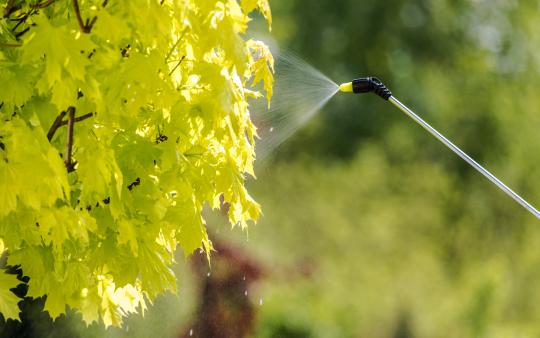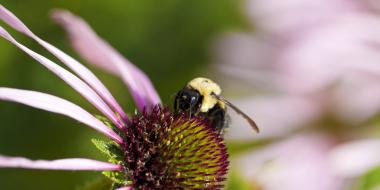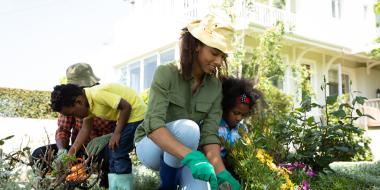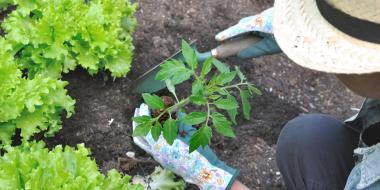It’s no secret that the healthier and heartier your plants are, the more they produce, and the more able they are to resist pests and disease. Healthy plants also mean a healthier soil biology. Plants that are photosynthesizing at high capacity have lots of extra sugars and carbon to share with the microbes in the soil (and more than enough left over to produce more nutritious fruit!). Those happy soil microbes then make soluble nutrients available to the plant roots, while any leftovers feed the next generation of microbes, creating a vigorous positive feedback loop. You can help make your plants and trees as healthy as they can be, by providing a little foliar nutrition with an easy-to-make holistic spray that’s both easy to use and guaranteed to get results!
Support plant defense mechanisms
A healthy immune system means a healthy organism. The rest of your household may be in bed with the flu but if your immune system is strong, it will most likely leave you unscathed. The same is true of plants. When harmful bacteria and fungus are detected by the plant, it produces polysaccharides, which activate their internal defence mechanisms: phytoalexin compounds. When there are enough of these terpenes and isoflavonoids produced, the plant can resist invading pathogens. Neem, an herb native to the Indian subcontinent, contains phytoalexin compounds and can stimulate the immune response of the plant to help ward off fungal diseases. Karanja oil can either be used in place of neem or in conjunction with it (half of each) as they have a synergistic effect.
In a healthy system there are many natural defence mechanisms. To achieve this in your garden, you need to support the underlying biology and increase biodiversity. And while conventional spray wisdom suggests a “kill everything in sight” approach, a holistic approach is far better, as too much stress and exposure to chemicals actually reduces plants’ capacity to defend themselves.
petroleum-based fertilizer can actually increase susceptibility to disease
Healthy soil, strong root systems, and good mycorrhizal fungal relationships are all important first steps in establishing plant health. In a fungally dominant soil, nitrogen is readily available in its best form—ammonium—for trees and shrubs, allowing them to better resist disease. Too much petroleum-based fertilizer can actually increase susceptibility to disease and pests as this form of nitrogen is not properly incorporated into plant tissues. The best way to achieve good soil-fungal relationships for a plant is to inoculate the roots with mycorrhiza at the time of planting, or if you’ve missed that window, add an inoculant as soon as you can. Mulch around the base of the plant with a mixed hardwood mulch to provide long-term food for the soil fungi.
Kelp extract is a storehouse of micro- and macronutrients like boron, copper, iron, manganese, and molybdenum. These provide foliar nutrition as well as readily available delectables for the soil food web, enhancing overall plant health and immunity.
Microorganisms make a difference
Just like people take probiotics to build up good gut bacteria, trees can also benefit from some bacteria love too! Good bacteria can help to colonize the leaves, branches, and trunks of plants so that there’s no room for the bad guys to set up shop. “Effective microorganisms” (cultures of natural and beneficial organisms combined to create inoculants designed to boost the microbial diversity of the soil) brewed from a nearby forest floor or purchased from a gardener’s supply store colonize the plant surface and soil with photosynthetic bacteria, lactic acid, bacteria, and yeasts. The increased microbial diversity of the leaf surface and soil leads to enhanced growth, yield, quality, and disease-resistance.
It also helps to make sure your spray contains some food for the good bacteria, like fatty acids, to keep them happy and multiplying. When there’s a food shortage, the good guys perish first and the bad guys will take over the surface of the leaf or trunk.
Fatty acids like neem and fish hydrolysate provide food for beneficial fungi as well as a nutritional boost for the tree through the leaves.
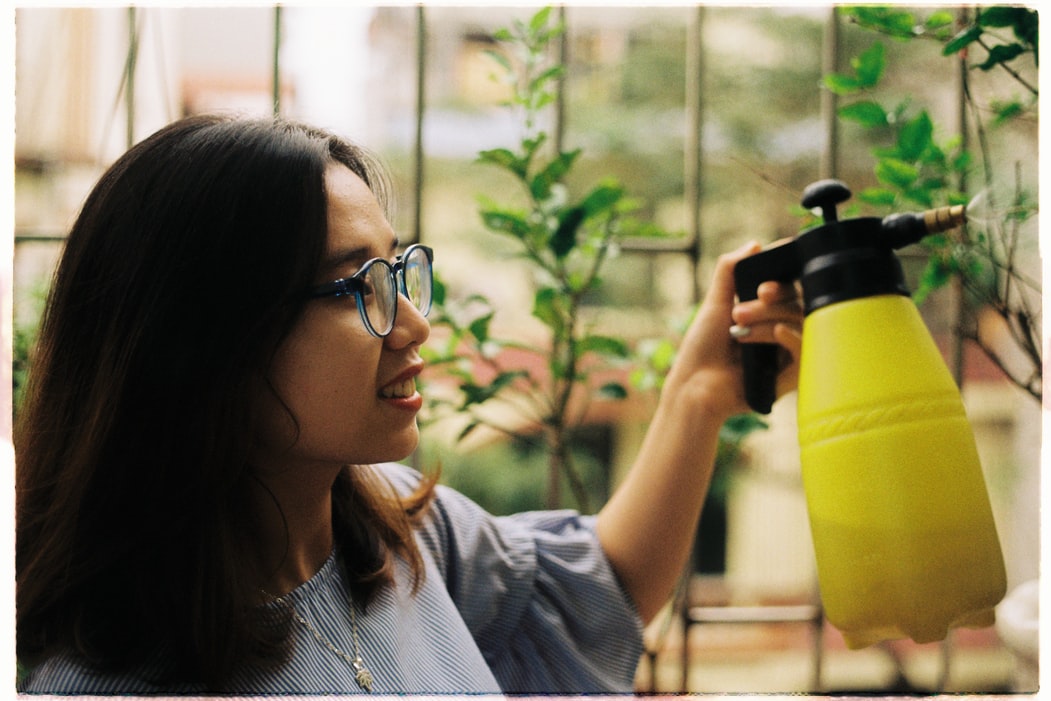
Bug Off!
It’s a little-known fact that a healthy plant will not be eaten by insect pests: they simply cannot digest it! An insect’s simple digestive system needs the incomplete proteins from stressed plants, since they can’t process complete proteins on their own. So, if there are aphids on your plant it’s because it was unhealthy to begin with!
Four-Step Spray Schedule
This spray is specifically geared towards fruit trees, but I use it on all my soft fruits and will often give my other plants a dose as I’m walking by. You can also target fallen fruit and undecomposed leaves in this soil application. Applied in four separate doses, the applications straddle the primary infection period for most tree diseases.
- The first application should take place when there is a tight or open cluster of leaves.
- The second spray should occur when the first smile of pink is showing on the flower buds (do not spray on open blossoms!).
- The third application can be right after petal fall.
- Make the final spray 7 to 10 days after petal fall.
- Apply in the fall as leaves begin to drop from trees, but double the concentrations of fish, microbes, and neem.
Note: Any trace minerals that you know are lacking in your soil or plant will have the biggest impact by adding them to sprays 2, 3, and 4.
Not-So-Top-Secret Recipe
by Michael Phillips, author of The Holistic Orchard
Ingredients
- 2.5 oz neem, or karanja oil, emulsified with 1 tsp dish soap
- 10 oz unpasteurized liquid fish hydrolysate
- 6–12 oz effective microorganisms mother culture stimulated with ½ cup of blackstrap molasses in warm water
- 5 Tbsp liquid kelp
Instructions
- Mix ingredients together and pour into a 5-gallon sprayer.
To use: It is best to have a full day without rain after application but if the weather is not cooperating, apply spray as early as possible before rainfall. If temperatures zoom up to 26.5°C spray very early in the morning or after twilight using half the neem rate. Make sure to spray the entire leaf surface, both top and underneath, until they are dripping. Spray branches, trunk, and the soil underneath the dripline.
Make your own garden spray
If the above recipe seems too daunting but you want to do something to help your trees then spray at least one of the ingredients on your plants, or try a herbal brew you can make using your own backyard finds! There are a wide variety of weeds that can provide good nutrition and resistance to your food crops. Be mindful: DIY fermented brews can be rather putrid-smelling so spray them on a day your neighbours are away!
The herbal helpers listed here are great starting points for your own customizable tree spray which can be used throughout the growing season.
Stinging nettle and horsetail are high in silica which helps build a strong cuticle (the skin of the leaf) that can prevent fungal spores from penetrating plant tissue.
Comfrey helps with calcium deficiencies.
Garlic scapes help plants to uptake the nutrients in your sprays.
Other helpful plants: Wormwood, horseradish, dock, and tansy.
Instructions
- Fill a 5-gallon bucket with lightly-packed fresh herbs.
- Pour a pot of boiling water over them to maximize nutrient extraction. Fill the rest of the bucket with unchlorinated water.
- Let sit for 7–10 days, covered with a loose lid to prevent evaporation.
To use: Add one quart of the liquid brew and enough water to fill a 4- to 5-gallon sprayer. Spray on plants as with the not-so-secret recipe and continue application regularly throughout the summer months. Silica and calcium are particularly important additions to consider.
Sure, the neighbours may wonder what the heck is going on when you’re walking around your yard with a backpack sprayer a few times a year dousing the trees, and you may sometimes smell a little fishy afterward, but spraying your plants to boost their immune systems and colonize them with good microorganisms, gives them the best opportunity to thrive for years to come!
You may also enjoy: Gardening for Absolute Beginners, Happy Gardening With Perennial Vegetables, and Planning the Garden with Kids.



